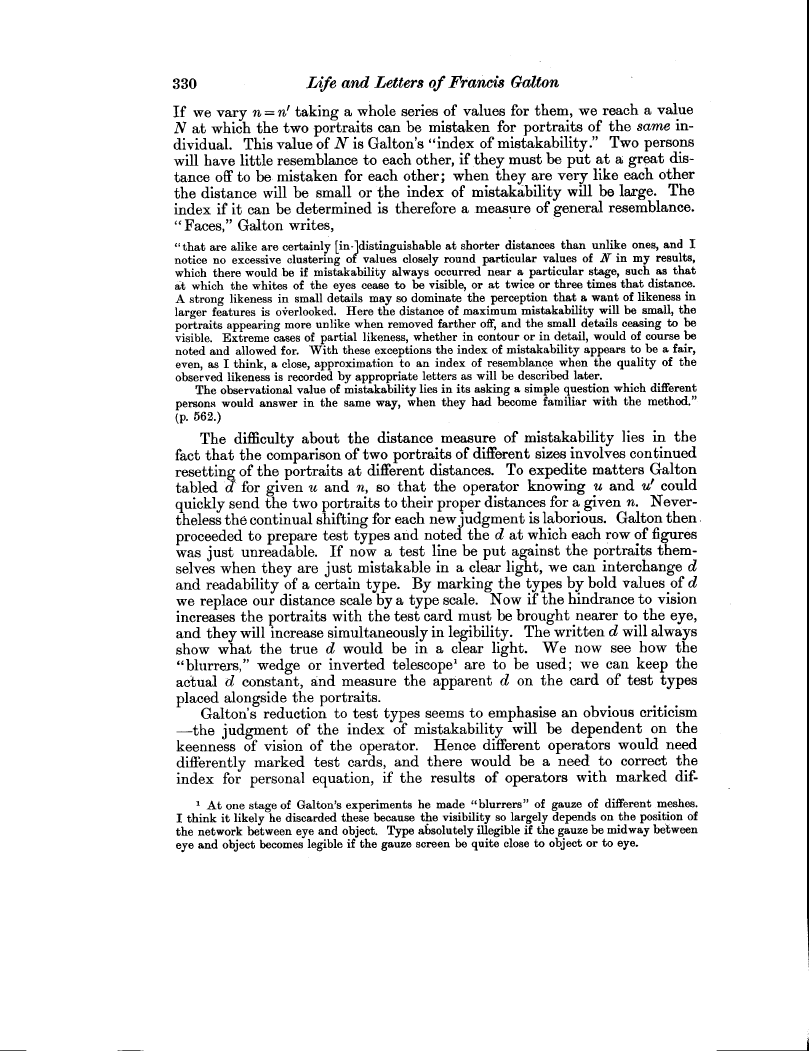330 Life and Letters of Francis Galton
If we vary n = n' taking a whole series of values for them, we reach a value N at which the two portraits can be mistaken for portraits of the same individual. This value of N is Galton's "index of mistakability." Two persons will have little resemblance to each other, if they must be put at a great distance off to be mistaken for each other; when they are very like each other the distance will be small or the index of mistakability will be large. The index if it can be determined is therefore a measure of general resemblance. "Faces," Galton writes,
"that are alike are certainly [in distinguishable at shorter distances than unlike ones, and I notice no excessive clustering o values closely round particular values of N in my results, which there would be if mistakability always occurred near a particular stage, such as that
at which the whites of the eyes cease to be visible, or at twice or three times that distance. A strong likeness in small details may so dominate the perception that a want of likeness in larger features is overlooked. Here the distance of maximum mistakability will be small, the portraits appearing more unlike when removed farther off, and the small details ceasing to be visible. Extreme cases of partial likeness, whether in contour or in detail, would of course be noted and allowed for. With these exceptions the index of mistakability appears to be a fair, even, as I think, a close, approximation to an index of resemblance when the quality of the observed likeness is recorded by appropriate letters as will be described later.
The observational value of mistakability lies in its asking a simple question which different
persons would answer in the same way, when they had become familiar with the method." (p. 562.)
The difficulty about the distance measure of mistakability lies in the fact that the comparison of two portraits of different sizes involves continued resetting of the portraits at different distances. To expedite matters Galton tabled d' for given u and n, so that the operator knowing u and u' could quickly send the two portraits to their proper distances for a given n. Nevertheless the continual shifting for each new judgment is laborious. Galton then . proceeded to prepare test types and noted the d at which each row of figures was just unreadable. If now a test line be put against the portraits themselves when they are just mistakable in a clear light, we can interchange d and readability of a certain type. By marking the types by bold values of d we replace our distance scale by a type scale. Now if the hindrance to vision increases the portraits with the test card must be brought nearer to the eye, and they will increase simultaneously in legibility. The written d will always show what the true d would be in a clear light. We now see how the "blurrers," wedge or inverted telescope' are to be used; we can keep the actual d constant, and measure the apparent d on the card of test types
placed alongside the portraits.
Galton's reduction to test types seems to emphasise an obvious criticism
-the judgment of the index of mistakability will be dependent on the keenness of vision of the operator. Hence different operators would need differently marked test cards, and there would be a need to correct the index for personal equation, if the results of operators with marked dif
1 At one stage of Galton's experiments he made "blurrers" of gauze of different meshes. I think it likely he discarded these because the visibility so largely depends on the position of the network between eye and object. Type absolutely illegible if the gauze be midway between eye and object becomes legible if the gauze screen be quite close to object or to eye.

